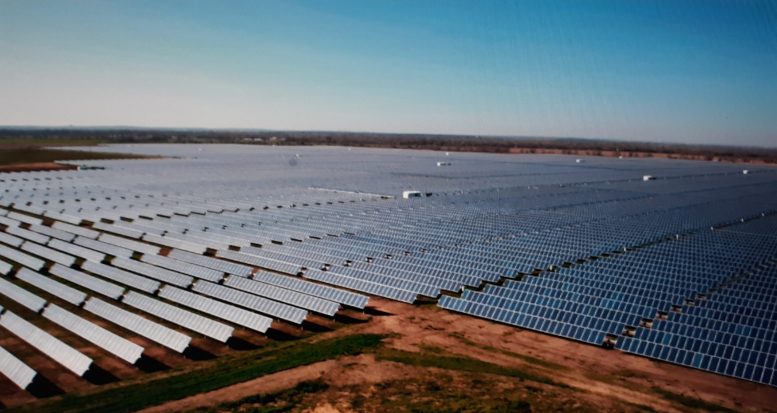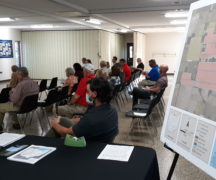By JAN LARSON McLAUGHLIN
BG Independent News
The developers of a proposed 600-acre solar project near Weston painted a sunny picture of their plans – but some neighbors remain skeptical of how their properties will be impacted.
During a recent public meeting, held virtually due to COVID, the founders of 7X Energy explained their plan for the solar project and answered emailed questions from residents near the proposed site.
Cliff Scher, a representative of 7X Energy, said the leaders of the solar firm are “veterans in the renewable energy industry.”
Scher explained the factors that led 7X Energy to select the site west of the village of Weston. The company looks for close proximity to existing electric substations and transmission lines, minimal environmental impact, adequate sunlight, and landowners willing to lease their acreage.
Conversations began with agricultural landowners in 2019 and some of the necessary studies have been conducted on the site, Scher said.
The proposed solar field would cover land currently farmed, and would be five times larger than Bowling Green’s solar project northeast of the city. It would produce about 101 MW of power – compared to the 20 MW generated at the Bowling Green solar site.
That would be enough to power about 20,000 average-sized homes, Scher said.
“We believe it’s feasible here,” he said.
The solar proposal outside Weston, which has been dubbed the Juliet Energy Project, appears to touch 28 residential properties, with most on Sand Ridge Road, Weston Road and Milton Road.
The project would benefit the Weston area, Scher said, with an estimated $400,000 annually in tax revenue for Otsego school district, about $35,000 a year to Weston Township and Milton Township, and about $3,000 a year to the village of Weston.
But neighbors who live right next door to the proposed solar field are worried about how the massive solar field will affect them. Some expressed frustration that they just found out a couple weeks ago about the project that has been in the works since 2019.
After the public meeting, 7X Energy officials said they made some changes to their plans based on comments from neighbors. Those changes were:
- Increasing the distance to the project fenceline of at least 100 feet from any adjacent residential property lines throughout the solar panel area.
- Adjusting the locations of solar panels to accommodate larger setbacks in locations off Milton Road, Sand Ridge Road and Weston Road.
The firm is still working on its landscape mitigation plan.
Some neighbors objected to just finding out about the project that has been in the planning stages for a couple years. They feel like the company is trying to “steamroll” the neighboring residents.
While they may not be able to stop the solar field, they would like some assurances that their property values won’t go down the tubes.
Representatives of 7X Energy said there is no evidence that solar projects have a negative impact on property value. Examining property value in states across the U.S. shows that large-scale solar arrays have no measurable impact on the value of adjacent properties, according to company officials. Proximity to solar farms does not deter the sales of agricultural or residential land, they said.
Questions asked by neighbors of the proposed solar field voiced concern for property values, health impact to humans and wildlife, and effects on drainage tiles.
One person asked if 7X Energy would be willing to pay adjacent residents the same price per acre per year that they are paying farmers they are leasing land from. Scher responded that 7X Energy is looking at providing some payments to the neighboring landowners that live next to the leased fields. The payment amounts are not calculated yet. But he added that there would be a difference from the solar field acreage, since 7X Energy would not be using the residential property.
“If you live next to a property that has solar facilities planned for it, you can either expect to hear from me or please reach out,” Scher said. “I would look forward to talking with you about that.”
Some asked about the effect of the solar field on pacemakers and defibrillators, plus AM/FM radio. One asked about the long-term effects of living by a solar field, such as from radiation. Scher responded that solar sites don’t generate radiation.
Many wondered about the type of buffers that might be planted between the solar field and residential lots.
“We’re definitely open to conversations about buffers,” Scher said.
Some questions were very specific, such as from a person whose wife is allergic to bees. He asked if 7X Energy would pay for her medical bills if she is stung by bees attracted by the pollinator plants put in as buffers to the solar field.
Others were concerned about noise generated by the solar field. They were told there would be a light humming right next to the transformers at the substation.
Some worried about drainage tile, with Scher saying that a maintenance plan will be put in place for drainage.
Residents asked if there would be any direct payments to landowners adjacent to the solar field. Scher replied there may be small payments through the life of the project.
Some asked about heat affecting nearby crops or birds that land on the solar panels. It was explained that the panels are designed to absorb, not reflect, so they don’t generate heat.
Others asked about invasive plant species spreading to neighboring farm fields. Scher said the native grasses will be mowed. “We don’t want shading on the solar panels,” he said.
“What are we going to get for benefits? We are the ones living right by it?” one neighbor asked.
Officials from 7X Energy said local benefits can include additional income from “good neighbor agreements,” a landscaped vegetative buffer, income from direct and indirect employment during construction and operations, annual payments to local jurisdictions and school districts for the life of the project, and land lease payments to participating landowners that could result in increased local spending. In addition, the project can benefit the local ecosystem by replacing cultivated crops with native grassland habitat, which should reduce runoff and the use of pesticides and herbicides in the area.
The 7X firm, which has been in business three years and is based in Austin, Texas, has four projects in the works in Ohio.
The Ohio Power Siting Board requires several studies be conducted prior to approving a solar field location. Those studies look at such factors as streams and wetlands, endangered species, noise and visual assessments, glare analysis, drainage, and the best transportation routes for delivery of materials to the site.
The Ohio Power Siting Board will hold a public hearing on the project in July.
Officials at 7X Energy hope to start construction on the Weston Township site in early 2022.
The life of the solar project is projected at 40 years.
The company will enter a road maintenance agreement with the governmental entities where the solar field sits, to make sure 7X Energy is a good neighbor during construction, Scher said.
The project would create 100-200 construction jobs. Once in operation, the site will have one to three full-time employees, and very little traffic.
Anyone with further questions may contact 7X Energy at 866-298-1632, ext. 116, or JulietSolar.com.


